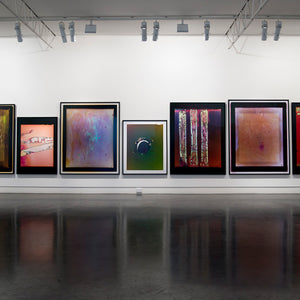Artist Statement
Made without a camera and over extended periods, my photographs embody a particular intersection of time and place, offering an autobiographical witnessing of the world, a memoire, rather than mere acts of representation. These photographs come into being as a result of two interrelated processes. The first involves a duration of bodily actions, in which pieces of film are left on their own to register performative gestures, or are otherwise forced to undergo a haptic rendering, where they are drawn on, handled, scratched, spat on and weathered, among other things. Each action is informed by the place and circumstances in which the film (and myself) happens to be located. Exposed to light for periods of months and even years, these pieces of film are processed and then printed in the darkroom (itself a process of transformation) to draw out the resultant traces left on them. Realised at large scale, the final photographs confront the viewer with ravaged memorials to lived experience. Appearing to be abstractions, they are in fact rigorous distillations of the real: they are entirely themselves and nothing more.
Over the past six years, I have made a number of series of works along these lines, all of them derived from the particularities of my location in, or movement between, Australia, New Zealand or Europe. The series titled Memoire is therefore born of a quite peculiar spatial and temporal arc. These are photographs that speak of displacement, negotiating a transaction between localities rather than offering a static celebration of origins. As the daughter of Hungarian immigrants to Australia, my own heritage has been transformed by an antipodean transcription; the world of my ancestors has been inverted and turned upside down while my own is always haunted by a mythological elsewhere. Through this mirroring, my life as an artist has been refracted and redoubled as a transitory existence, belonging neither here nor there. I seek to harness this liminal social space as a means of shaping a personal relationship to the world through my photography. The emulsion of each of my works is choreographed as a kind of photographic skin; this skin supports a fragile armature of place and the echo of its memory.
Abrasion, for example, was left out in the New Zealand weather over a period of two months to suffer its vicissitudes. Otherworldly in appearance, yet made of a palpably vulnerable material, the (mis)treatment of its negative is evidenced through the bruising and scarring of the print’s chromatic surface. Like a fault in the material, a ruination is always already imminent within my work. That material obeys its own rules, a refusal to be controlled that is there from the beginning of my process but only reveals itself in the end.
Marking Time is scarred by lines I scratched into the negative’s emulsion to record the absence of a loved one. These scratches became temporal inscriptions in which one day followed the next, with each leaving a scar on the filmic surface. But in fact, when I made these marks, the nature of the material dispersed the hierarchy of time both perspectively and linearly. In this way Marking Time articulates the passing of time as simultaneously wanted and unwanted (and so as something to be disrupted, to be pulled this way and that). The hierarchy of experience is reversed and its temporality dissolved. This photograph, although a single frame, is therefore not still. It speaks of duration but also of endurance, of longing but also of doubt, of mind but also of flesh. Through it one can gain access to a complicated experience of time and memory that is otherwise impossible to represent.
In recent exhibitions I have also included a component installed upon the gallery walls in a manner that recalls the printing process itself. I collage together prints and test strips alike to resemble the way I viewed them and made them in the photographic lab. This assemblage includes elements of fogged, unprocessed Kodak photo paper. This paper offers the warm tone that is present before I begin each and every test strip – the complexion that resides beneath all of my photographs. In fact, each and every test strip and print I made while preparing Memoire was brought into the gallery during the installation of the exhibition. This is the archive of my photographs; collectively, it represents their memory. In the gallery space, this drawing with photographs envelopes the body in photographic experience. The logic of my process of production is thereby carried through to the exhibition, an experience by which we are looking through and at photography, even as it calls on us to look directly at the medium’s photographicness. These assembled fragments offer a displacement by which I am all but erased, except for a smudge in the centre, or a fingerprint at the edge. My viewpoint is subsumed to an economy of production in which I am to be found everywhere and nowhere at once.

















